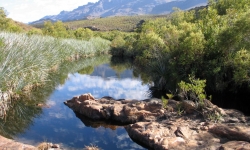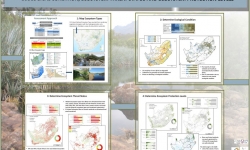National Biodiversity Assessment
The exceptional biodiversity and high endemism in South Africa is matched by the country’s high cultural diversity and its need for sustainable development. The challenging socio-economic setting combined with global change pressures make the assessment and monitoring of biodiversity and ecosystems an essential undertaking. The National Biodiversity Assessment (NBA) is a product of high scientific importance (i.e. best available science) led by the South African National Biodiversity Institute (SANBI) in collaboration with several other partner organisations. This multi-author and multi-stakeholder project is the primary tool for monitoring and reporting on the state of biodiversity in South Africa.
It is used to inform policies, strategies, decision-making and actions in range of sectors (e.g. water, agriculture and mining) for managing and conserving biodiversity more effectively. Specifically, the NBA uses two headline indicators, ecosystem threat status and protection level, for tracking the status of ecosystems in South Africa, with a view to understanding trends over time. It includes spatial as well as non-spatial elements covering terrestrial, freshwater, estuarine and marine components. The freshwater or inland aquatic component deals with both wetlands and rivers.
The Council for Scientific and Industrial Research (CSIR) played a particularly important role in the National Spatial Biodiversity Assessment (NBSA) 2004 and NBA 2011 and again provided leadership and technical capacity for the freshwater and estuarine components in the NBA 2018. The NBSA 2004 was the first systematic and spatial NBA done for South Africa. This was followed by a nationwide initiative to identify and protect South Africa’s Freshwater Ecosystem Priority Areas (FEPAs). The data for identifying the FEPAs were produced during the National Freshwater Priority Areas (NFEPA) project and fed seamlessly into the second NBA 2011, which included an assessment of both rivers and wetlands. The NBA 2018 then used river data (ecosystem types and condition) developed for NFEPA project to determine ecosystem threat status and protection levels.
This NBA involved nearly five years of ground-breaking work from 2015 to 2019. Over 470 individuals from approximately 90 institutions have worked persistently in providing and processing data, participating in collaborative workshops, authoring chapters on technical reports, and acting as experts and reviewers for the various NBA components. The latter was launched by the Minster of Environment Forestry and Fisheries, Ms Barbara Creecy on 3 October 2019. The inventory, component technical and synthesis reports as well as the spatial data and metadata are available from the NBA webpage and here https://drive.google.com/open?id=1khFJ1ZFMlCsKSuv0e2lRS35ufCJTRCr4.
Key messages identified were:
- Biodiversity provides jobs
- Healthy ecosystems are essential for water security
- Water flowing into the sea provides multiple benefits to people
- Small high-value ecosystem types take up just 5% of South Africa’s territory, but provide disproportionate benefits to people
- Benefits from fishing are at risk, including food and job security
- Estuaries and wetland are the most threated and least protected ecosystems in the country
- Freshwater fishes are the most threatened species group in South Africa
- Trends in threat status show rapid declines in some of South Africa’s species, especially freshwater species and butterflies
- Climate change is impacting on people and ecosystems; in spite of this, healthy ecosystems can help us adapt to climate change
- Protected areas: investment success in the ocean and on land
- Cooperative governance is essential for healthy landscapes and seascapes
- Areas where pressures are concentrated should be priorities for spatial planning
- South Africa’s new seamless map of ecosystem types paves the way for improved assessment, planning and monitoring
- Investment in strategic and collaborative biodiversity monitoring programmes is crucial to inform management and decision making and for biodiversity assessments




